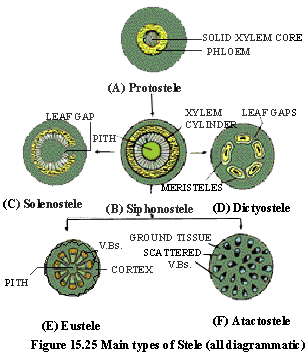|
PinkMonkey Online Study Guide-Biology
ii) Siphonostele (Fig 15.25B): It has evolved
from the protostele. In siphonostele, pith is present in the center
of the xylem cylinder. The phloem is external to xylem.
iii) Solenostele (Fig. 15.25): A Cbroken
at one point at a time due to the non-overlapping leaf gaps is called
solenostele
iv) Dictyostele (Fig. 15.25D): Siphonostele in
which many overlapping leaf gaps occur at the same level is called a dictyostele,
or dissected siphonostele. In a transverse section it appears broken into
many smaller or larger arcs. Each arc is known as a merestele (e.g.
fern rhizome). Each meristele is completely and independently surrounded
by the pericycle and the endodermis. This is the most highly- evolved
stele type in Pteridophyta.

v). Eustele (Fig. 15.25E): The characteristic
stele present in dicot and gymnosperm stems is called a eustele (i.e."
true" stele). It is also a dissected siphonostele in which the vascular
cylinder is dissected into separate vascular bundles arranged in a ring.
The entire ring of vascular bundles is surrounded by the pericycle and
the endodermis.
v) Atactostele ( Fig. 15.25F): This is a complex type
of stele in which numerous vascular bundles remain irregularly scattered
in the ground tissue (atactos means without any order). Atactostele
is a characteristic of monocot stems. Here, due to the scattered vascular
bundles, the cortex and stele are not demarcated. Similarly, the endodermis
and the pericycle are not differentiated.

|
SUMMARY- VASCULARIZATION
Conducting tissues in sporophyte plant
body of vascular plants were evolved in response to terrestrial
habitat. Xylem conducts water and minerals, while phloem conducts
organic solutes. The strands of xylem and phloem form vascular
bundles, which may or may not have cambium. The vascular
bundles are organized into various types of stele. The simplest
type is the protostele, while the eustele of dicots and the atactostele
of monocots are supposed to be the most evolutionary advanced
type.
|
|